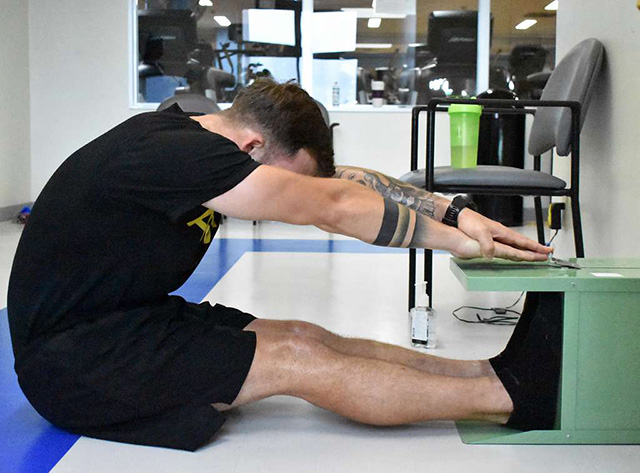This test measures the flexibility of the lower back and hamstring muscles. This following describes the procedures as used in the President's Challenge Fitness Awards. There are several other versions of the sit and reach test.
equipment required: sit and reach box (or alternatively a ruler can be used, held between the feet).
pre-test: Explain the test procedures to the subject. Perform screening of health risks and obtain informed consent. Prepare forms and record basic information such as age, height, body weight, gender, test conditions. Perform an appropriate warm-up. See more details of pre-test procedures.
procedure: This test involves sitting on the floor with legs out straight ahead. Feet (shoes off) are placed with the soles flat against the box, shoulder-width apart. Both knees are held flat against the floor by the tester, if required. With hands on top of each other and palms facing down, the subject reaches forward along the measuring line as far as possible. After three practice reaches, the fourth reach is held for at least two seconds while the distance is recorded. Make sure there are no jerky movements, and that the fingertips remain level and the legs flat. See also video demonstrations of the Sit and Reach Test.
 sit and reach test
sit and reach testscoring: The score is recorded to the nearest centimeter or half inch as the distance reached by the tip of the fingers. The usual scale used for the Presidents Challenge testing has the zero mark at 9 inches (23 cm) before the feet, therefore if the subject can reach their toes, their score is 9 inches.
variations: See the general sit and reach procedure page for a list of other sit and reach test variations. The variations mostly involve differences in the placement of the zero mark.
validity: This tests only measures the flexibility of the lower back and hamstrings, and is a valid measure of this.
reliability: The reliability will depend on the amount of warm-up allowed, and whether the same procedures are followed each time. Most norms are based on no previous warm-up, though the best results will be achieved after a warm up or if the test is proceeded by a test such as the endurance test.
advantages: This is the most commonly used test of flexibility, so there is lots of data for comparison. Also, it is a easy and quick test to perform. Using the zero mark 9 inches before the feet means that most scores will be a positive number, easier to compare and analyze.
disadvantages: Standard sit and reach tests such as this one use a set reference point which does not allow for variations in the length of arms and legs of the person being tested - people with long arms and/or short legs would get a better result, while those with short arms and/or long legs are at a disadvantage. The modified sit and reach test is designed to control for this. Also, this flexibility test is specific to the range of motion and muscles and joints of the lower back and hamstrings, and is not necessarily transferable to other regions. More flexibility tests are required to measure the specific regions of the body.
other comments: Lower back flexibility is important because tightness in this area is implicated in lumbar lordosis, forward pelvic tilt and lower back pain.
The Test in Action
- This version of the test is used in the President's Challenge Fitness Awards
Similar Tests
- The general Sit and Reach test procedure
- Other versions of the sit and reach test.
Related Pages
- Sit and Reach Test Results.
- Make your own Sit and Reach testing box.
- The President's Challenge Fitness Awards.
- Other flexibility tests.
- Hamstring flexibility exercises on this list of stretches.
- Sit and Reach Test Videos and other Flexibility Test Videos
Related Products
- Sit and reach boxes — see what is available
- Buy a sit and reach box
- Flexibility Store — items to measure flexibility.


 Current Events
Current Events